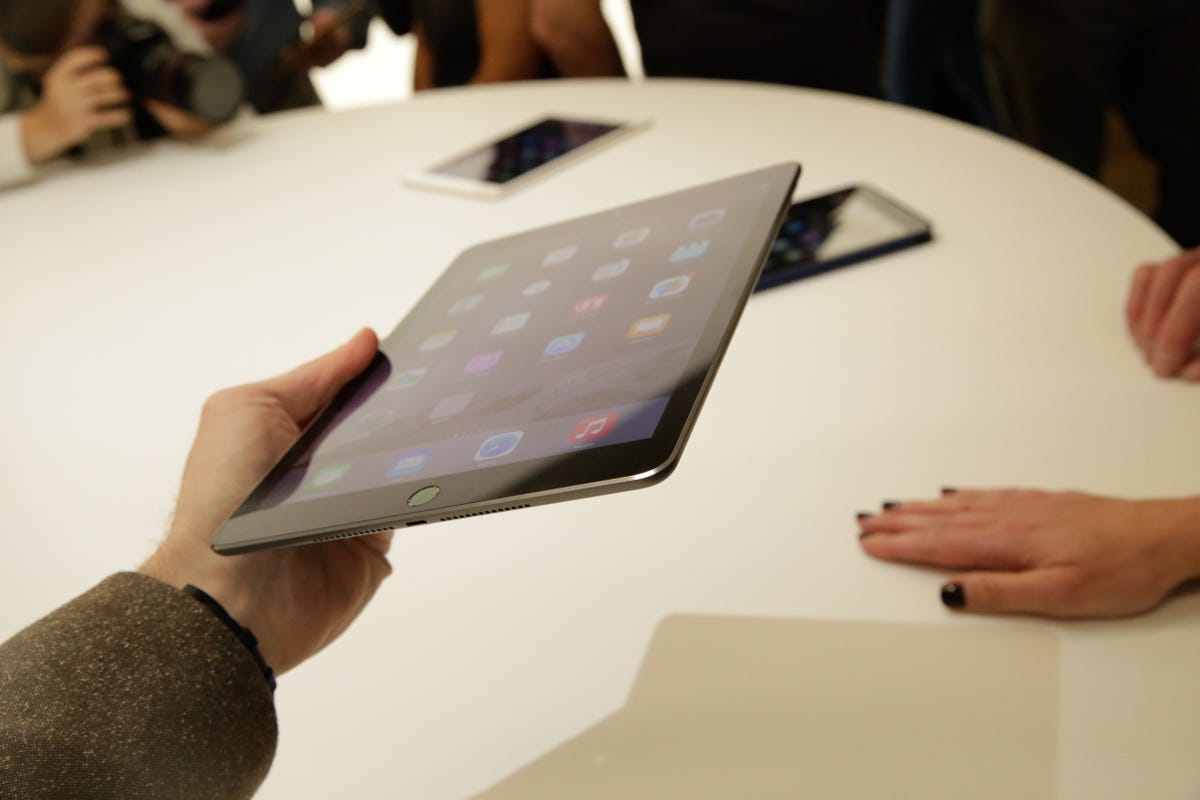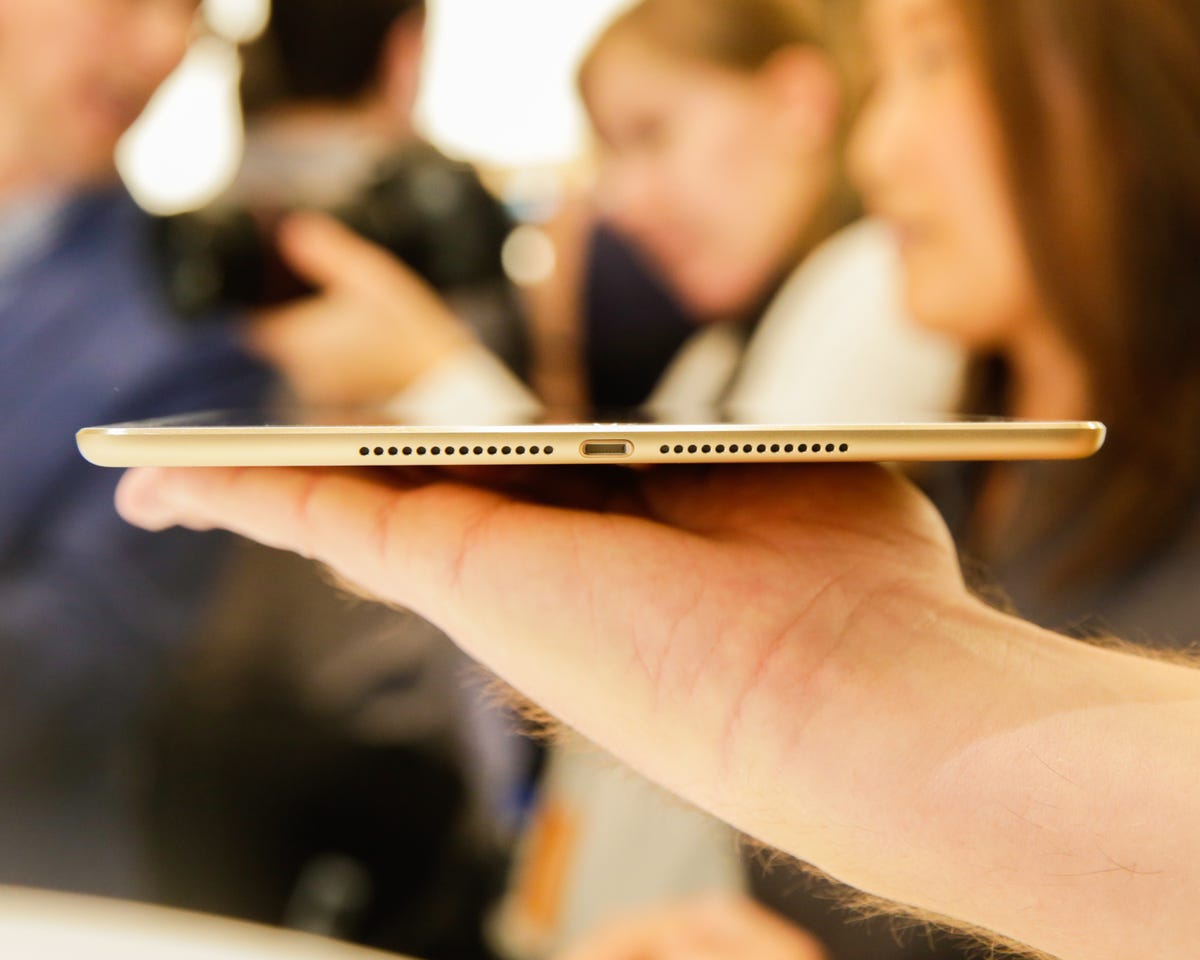
James Martin/CNET
Having already won a standing ovation for its iPhone 6 and iPhone 6 Plus smartphones, Apple seemed content with garnering polite applause for its newest iPads and Macs.
At least, that’s what it looked like after CEO Tim Cook on Thursday unveiled the iPad Air 2, iPad Mini 3, a new Retina 5K Display-packing iMac desktop computer and an upgraded Mac Mini computer at an event that was heavy on filler and, surprisingly, comedy.
The enhancements to each device were welcome, but not earth-shattering.
While the mature PC business has settled into the occasional incremental update, tablets are at a potentially more critical turning point: Are there still more days of wild growth ahead, or is the recent slump a sign of things to come? Recent data and Apple’s own financial performance suggests it’s the latter, with a sluggish market looking for a jolt of innovation and enthusiasm.
Apple instead opted to play it safe. After shaking off criticism that it lacked the ability to “think different” by debuting the Apple Watch and the larger-screen iPhone 6 and iPhone 6 Plus, it went back to its old ways — proffering incremental updates to existing products with Thursday’s announcements.
Related stories
- Apple fields iPad Air 2 to breathe new life into tablet sales
- Apple iPad Mini 3 seeks middle ground between phablets, larger tablets
- With ‘Retina 5K’ iMac, Apple caters to HD junkies
- Apple Pay mobile payment service to launch Monday
The new iPad Air 2 and iPad Mini 3 seem almost perfunctory. The iPad Air 2 is housed in a thinner and lighter body, boasts a faster processor and gains the Touch ID fingerprint-reading home key that debuted a year ago in the iPhone 5S. The iPad Mini 3, which was essentially glossed over, also gets Touch ID.
“Unless you really want it for the better camera capability on your iPad or are dying to have the thinnest iPad yet, there’s not a huge incentive to upgrade from the previous model,” said Lynette Luna, an analyst at Current Analysis.
Specs and year-old features don’t consumers excited. And they badly need a reason to buy a new tablet, as people who own one are more than likely to hang on to it rather than trade up to a new device.
That’s why the tablet market is starting to see its growth stall. The category is expected to post full-year shipment growth of 11 percent over 2013, respectable until you compare that to the year-over-year growth of 55 percent the tablet market experienced last year, according to market research firm Gartner.
iPad in a rut?
Apple’s results more dramatically illustrate the stagnant market. While the iPad remains the top-selling tablet, sales have declined from a year ago and have fallen short of Wall Street expectations for two straight quarters. That begs the question: Have tablets, and specifically the iPad line, peaked?
Apple argues it hasn’t. Cook today cited the 100 percent customer satisfaction rate for the iPad — an unusually high score for any product. He also touted the iPad’s key advantage: The 675,000 apps specifically designed for the tablet. Apple has sold 225 million iPads since the device was introduced by former CEO Steve Jobs in 2010.
And some do believe Apple was wise to stick with modest improvements. “Being safe might actually yield a better return,” said Carolina Milanesi, an analyst at Kantar Worldwide. “They’re trying to improve something that is best in class.”


James Martin/CNET
It’s easy to see how the once exploding category has fallen back to earth. Tablets aren’t the same kind of personal device as a smartphone, which gets replaced every two years — or less. They’re more like PCs, with consumers willing to make do with an aging gadget for longer periods.
The advent of large-screen smartphones, known as phablets because they look like a mash-up between a phone and tablet, are also eating away at the need for the larger tablet. Some phablets, including Samsung’s Galaxy Note line, are packed with a smart stylus and tools that enable people to use them as their primary computing device.
“There was nothing in today’s announcements which would convince someone who’s stopped using an existing iPad to buy a new one — the new iPads do the same things better, but don’t do anything dramatically new and different,” said Jan Dawson, an analyst at Jackdaw Research. “For people who have found a large smartphone and a laptop sufficient, the new iPads won’t change the equation.”
Low-cost tablets, such as the Nexus 7, a competitive tablet from Asus that is $270 less than the base iPad Air, are also eating into Apple’s share. On Wednesday, Google unveiled a new Nexus products, including the larger Nexus 9 tablet, priced at $399 — that’s $100 less than the iPad Air.
To offset that, Apple is keeping its original iPad Mini and pricing it at $249. It’s also keeping its year-old iPad Mini 2 and iPad Air, fleshing out its product portfolio to hit a range of prices between $249 and the base $499 iPad Air 2.
“The $249 iPad Mini is a nice door opener for them,” Milanesi said.
Perhaps the jolt Apple needs will come next year, when it’s expected to unveil a larger “iPad Pro” for the business and professional market.
Mac line gets badly needed refresh
The tagline of Apple’s event invitation, “It’s been way too long,” may have referred more to its Mac lineup. Both the iMac desktop and Mac Mini got an upgrade — the first time Apple has made significant tweaks to both computers in two years.
The iMac finally joined the club of Apple devices with a higher-resolution Retina Display. The iMac now has an option of a Retina 5K Display, with a resolution of 5,120×2,880 and 14.7 million pixels.
“It is stunning,” said Philip Schiller, senior vice president of marketing for Apple.


CNET
But at $2,499, the iMac with Retina 5K Display is a niche product. Analysts believe there will be a market for those who highly value an improved screen. Apple interestingly compared the iMac to Ultra HD televisions instead of comparing it to other desktop computers. Schiller said the 5K Display has 67 percent more pixels than an Ultra HDTV.
The Mac Mini, Apple’s most affordable computer, also got an upgrade, although the design remained the same (it’s a box that ships without a monitor, keyboard or mouse). The biggest change: a $100 haircut off the starting price, which now begins at $499.
Apple’s Mac business might not be as big — or as sexy — as its mobile business, but it remains an important focus for Apple. The company now generates less than 15 percent of its revenue from Macs, but the devices help flesh out its family of products — which are increasingly designed to work together.


Now playing:
Watch this:
Apple demos Continuity with call to Colbert
2:20
Apple in July reported Mac unit sales rose 18 percent to 4.4 million in the quarter ended June 28. Cook said the Mac boosted Apple’s overall financial results, and the company saw strong sales in some regions weak for other PC makers.
Apple hasn’t yet reported its most recent quarter, but research firm IDC last week said the company moved into the No. 5 ranking for global PC sales in the calendar third quarter. For the past several years, Apple has controlled a much smaller chunk of the market, but its sleek designs, such as the MacBook Air, have attracted customers.
Software gets turn in the limelight
Apple spent time delving into the software side, underscoring the importance of the company’s strategy of controlling all aspects of the user experience. One of Apple’s upcoming key advantages will be the ability to have hand-offs between its various products.
The company spent a large chunk of the presentation at the beginning running through many of the features it showed off at the Worldwide Developers Conference in June, peppered with bits of comedy, including an audio appearance by comedian and TV host Stephen Colbert and a parody video on Apple’s intense handshake security.
Apple touched upon desktop operating system OS X 10.10 Yosemite, which most importantly will be able to synchronize with mobile operating system iOS through AirDrop file-sharing, iMessage messaging, and the ability to make and receive phone calls.
As with OS X Mavericks last year, Apple said Yosemite would be free to download, and made the software available after the event ended on Thursday.


Apple
Craig Federighi, senior vice president of software engineering overseeing iOS and Mac OS X, tacitly acknowledged the issues with iOS 8. The initial release of iOS 8 caused issues with connectivity, slower performance on Safari and lag in some apps such as photos. Apple also removed the camera roll folder in Photos, which users complained about.
“When we put a major new OS in the hands of hundreds of millions of users, we do get a little feedback,” he said, drawing guffaws from the audience.
Fererighi briefly talked about iOS 8.1, which brings back camera roll.
Also coming with iOS 8.1 is Apple Pay, which will allow users to pay for goods at retailers and restaurants using a special chip found in the iPhone 6 and iPhone 6 Plus and the TouchID sensor for verification.
The service, which was unveiled last month at the iPhone event, but hasn’t gone live, has the potential to transform how we pay for goods and services, and accelerate the long-gestating advent of the mobile wallet.
Apple said Apple Pay would launch on Monday.



